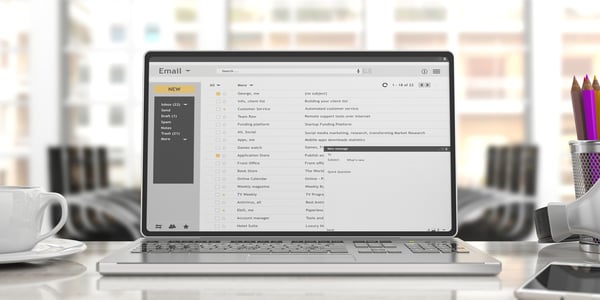
Email marketing might seem to be a little old-fashioned at this point. The prevalence of spam email might make some companies less inclined to use it. However, email marketing is still a great way to drive revenue as long as you do it correctly. Here are some best practices to create, or improve, your email marketing campaign.

Email marketing is still a very effective way to drive revenue. On average, 18% of recipients will open your marketing emails, and 2.69% will click through. Click through rates remain high despite concerns about phishing (and some recipients may manually type in the URL).
Email is valuable for a number of other reasons:
So on to some best practices.
When people don't open your email, a lot of the time it's because they consider it to be, or mistake it for spam. 72% of marketers use personalization in email campaigns, and that's because it works. "Blast" emails are much more likely to be ignored than ones which are relevant to the customer. This does not just mean adding the person's name, but making sure that the content they receive makes sense to them.
For existing customers, you can personalize based off of their purchase history. Larger companies are starting to use machine learning for this (Amazon's recommendation algorithms are a classic example), and the costs of this are starting to come within the reach of medium sized to small businesses. You can also have multiple lists based on exactly how a customer provided their email. Send different emails to each list, emphasizing different products or aspects of your product. People are more likely to buy things which are relevant and less likely to put your emails right in the spam folder if they seem to show some care for what they want.
Another way to make sure people open your emails is to avoid a boring, uninteresting, or generic subject line. Marketers have discovered that subject lines that create a sense of urgency increase B2C open rates by as much as 22%. Use words like "Limited," "Last chance" and "Hurry" to get people to open your emails. Then, of course, you need to follow up with a limited time deal to get them to click back to your website. Hopefully once they are there they'll buy something else as well. This also works well for B2B. Keep testing, though. Reader perceptions change over time, and a word that has a positive impact today may not tomorrow.
Other tactics that can increase open rates include:
Avoid using donotreply (this drops click rates a lot).
Don't forget to test your subject line.
Too many emails may increase your unsubscribe rate. The same is true for sending too few. (I forgot I was on that mailing list, and they never really send anything). So, when do people unsubscribe to email marketing lists?
The average unsubscribe rate across all industries is 0.15%. Ninety two percent of people who unsubscribe haven't opened an email from that sender in over a year. These people aren't going to be buying something from you anyway! People are more accepting of marketing emails than you might think.
Statistics, in fact, show that the effective number for B2B emails is 4 to 6 times a month. For B2C businesses the most effective is between ten and fourteen times a month. You don't want to be spamming people every day, but you want to be sending enough to keep yourself relevant in their eyes and keep their attention on you.
In other words, you need to increase engagement. Open rates rise when you send at least 5 times per month. Personalized and relevant emails can elicit a reaction of feeling special about your communications, rather than sick of them. Some people will get sick of emails regardless, and those respond better to other advertising methods.
Automation is your friend. If you have a good marketing platform (Hubspot works well for this), you can actually use how a customer interacts with your website to send relevant emails. This might include:
Modern machine learning can even do this almost automatically, as long as you have the email itself put together.
Lead scoring is using data to assign points to each lead you generate. You can assign points based on multiple attributes or in multiple areas. In addition to using lead scoring to assess the overall value of a lead, you can also use it to ascertain what product or service your lead is most interested in.
For example, a pest control company might use the person's location, the type of dwelling they live in, and other information to anticipate what kind of pest problems are the most likely. The result can determine which highly targeted email campaign the prospect should be added to.. For example, if they have a lot of trees in their yard you may have an email list for common tree pests in the area. You can use online behavior, demographic information, email engagement, etc to establish both the value of a lead and the best way to personalize marketing to them.
You may decide not to enroll a low score lead in any campaigns.
A B testing is important for all of your marketing efforts. For email, this can be as simple as splitting your list randomly into two halves and sending out two different messages. You can then compare open and click through rates between the two.
You need to do your testing over a period of time, not over one single message. Decide what you are testing ("Limited" versus "Exclusive" in the subject line, for example) and stick to it across a variety of emails. Compare your test messages only with each other, not with any other campaigns.
Once you have established which variant works best, you can use it for everyone on the list. But, always be on the lookout for drop offs in the response rate. That may indicate that a campaign has become "tired".
In the old days of direct mail marketing you would send your flyer out to everyone in the zip code. Although there are ways to do that with email, it's often a quick way to get your emails sent directly to the spam folder. Anti-spam code can even detect these kinds of mass email.
Instead, you need to follow proper practices for capturing leads. Here are a few ways you can do it:
A lot of people are more willing to hand over their email address if they think they are going to get something in return.

You can save a lot of time by using an email marketing platform. Some of them (like Mailchimp) are even free up to a certain number of subscribers. Some just do email and some offer a full-blown marketing platform.
Which platform is best depends on your needs and budget. You'll pay less for something primarily for email. If you're planning to expand your digital marketing strategy to include more than email, you will probably be better off with a full-featured marketing platform. It will save you the time and expensive of later integrating, or migrating away from, your existing email platform.
You need to track and analyze your campaigns properly. A B testing has already been mentioned, but it's vital to track open rates, click through rates, and conversion rates.
Low open rate indicates a problem with your subject line or your targeting. Low click to open rate indicates that the problem is in the email itself, perhaps the layout. Low conversion may show an issue with your website. Common problems may include visible HTML code on mobile devices (Always test your campaigns on both Android and iOS devices), poor formatting of the email, or emails which look shady. A sudden drop in open rate may also indicate that somebody is trying to impersonate you to phish people.
Eniture Technology specializes in helping e-Commerce merchants grow by providing useful information, digital marketing services, off-the-shelf apps that solve common problems, and custom programming services. Please contact us if you need help growing your online business or implementing the concepts presented in this blog post.
Interested in learning more? Start with our free guide on how to increase online sales, and subscribe to our blog!
GET IN TOUCH
Phone: 404.369.0680
info@eniture.com
320 W. Lanier Avenue
Suite 200
Fayetteville, GA 30214
© 2015 Eniture LLC. All rights reserved.